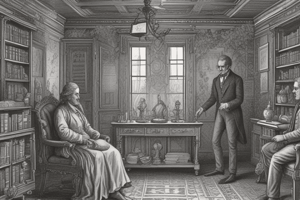Podcast
Questions and Answers
What was a key theme commonly covered in the literature of writers during the Victorian era?
What was a key theme commonly covered in the literature of writers during the Victorian era?
- Space exploration
- Political revolutions
- Technological advancements
- Social inequality (correct)
Which artistic movement gained prominence in the visual arts during the Victorian era?
Which artistic movement gained prominence in the visual arts during the Victorian era?
- Cubism and Surrealism
- Abstract Expressionism
- Realism and Impressionism (correct)
- Baroque
What was a central aspect of the Victorian ideal of respectability?
What was a central aspect of the Victorian ideal of respectability?
- Emphasis on material possessions
- Solo individualism
- Marriage and family (correct)
- Rejection of religious beliefs
What reinforced the belief that a woman's primary role was within the home during the Victorian era?
What reinforced the belief that a woman's primary role was within the home during the Victorian era?
What shaped British culture significantly during the Victorian era, creating a deeply religious society?
What shaped British culture significantly during the Victorian era, creating a deeply religious society?
How did public decency influence personal behavior during the Victorian era?
How did public decency influence personal behavior during the Victorian era?
What characterized the social hierarchy during the Victorian era?
What characterized the social hierarchy during the Victorian era?
Who occupied the top tier of the Victorian social hierarchy?
Who occupied the top tier of the Victorian social hierarchy?
How did social mobility generally operate in the Victorian era?
How did social mobility generally operate in the Victorian era?
What artistic movements influenced British literature and art during the Victorian era?
What artistic movements influenced British literature and art during the Victorian era?
Which group controlled the economy and politics at the top of the Victorian social hierarchy?
Which group controlled the economy and politics at the top of the Victorian social hierarchy?
What played a significant role in shaping morality and values during the Victorian era?
What played a significant role in shaping morality and values during the Victorian era?
Flashcards are hidden until you start studying
Study Notes
During the Victorian era in Britain, which spanned from Queen Victoria's ascension to the throne in 1837 until her death in 1901, society was organized around a strict social hierarchy with distinct classes, literature and arts thrived, and morality and values were heavily influenced by religious beliefs and societal norms. These aspects of the Victorian era have been widely studied and documented, providing insight into the unique cultural, artistic, and philosophical landscape of this historically significant period.
Social Class Hierarchy
The Victorian era saw a well-defined and rigid class structure, shaped largely by wealth and occupation. At the top were the nobility, aristocrats, and the wealthy bourgeoisie who controlled the economy and politics. Below them were the middle class - consisting of merchants, professionals, clerks, shopkeepers, and small landowners - followed by the working class, including skilled laborers, unskilled workers, and factory workers. This system of social stratification ensured that individuals knew their place within society and maintained the power dynamics of the time.
Social mobility during this period was limited despite some upward movement among hardworking people. While there were instances where someone could rise above their perceived station, it remained exceptional rather than commonplace.
Literature and Art
British literature and art during the Victorian era flourished under the influence of Romanticism and Realism. Writers like Charles Dickens, Elizabeth Barrett Browning, Oscar Wilde, Thomas Hardy, and Robert Browning emerged during this period, producing a diverse range of literature that reflected society's values, aspirations, and conflicts. Their works covered themes such as love, tragedy, morality, and social commentary.
The visual arts saw a shift towards realism and impressionism, with painters like John Everett Millais, Ford Madox Brown, William Holman Hunt, and J.M.W. Turner gaining prominence. Photography also gained popularity among the upper class as a means of documenting their lives and possessions.
Morality and Values
Victorian morality was profoundly shaped by religious beliefs, particularly Christianity, and societal norms. Public decency was emphasized, leading to strict codes of conduct governing personal behavior. Sexuality was considered a private matter and discussed behind closed doors. Marriage and family were central to the Victorian ideal of respectability, with women expected to marry and raise children.
The concept of 'domestic ideology' emerged, encouraging women to be virtuous mothers and homemakers. This reinforced the belief that a woman's primary role was within the home, while men should focus on public life and work.
Conclusion
The Victorian era was marked by a rigid social hierarchy, a flourishing of literature and art, and a deeply religious and morally guided society. These defining characteristics shaped British culture and influenced subsequent eras, making the Victorian period a pivotal point in British history.
Studying That Suits You
Use AI to generate personalized quizzes and flashcards to suit your learning preferences.





